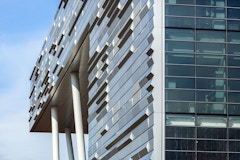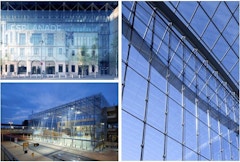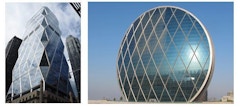280 results
-
How has the role of the façade evolved in light of the COVID-19 pandemic and ongoing fight to combat the climate change crisis? As companies grapple…
-
Facades Education in the United States
- Paper by Ajla Aksamija, PhD · Suncica Milosevic · Gabrielle Brainard · Timothy Brown
This paper presents the results of a research study, outlining the state of facades education at higher-education institutions across the United
-
Adaptive Facades
- Paper by Walter Haase · Werner Sobek · Enrica Oliva · Michele Andaloro
Facade engineering aims at appropriately balancing the demands imposed by the context and the capabilities inherent to the materials, the geometries
-

Prefab Facades – from Prototype to Product?
- Paper by Lisa Rammig · Andrea Zani · Tim Murphy
Building envelopes are not only an immediately visible part of the building, they have also become a major factor both for cost and performance of
-

Thermoelectric Facades
- Paper by Ajla Aksamija, PhD, LEED AP BD+C, CDT, Associate Professor Zlatan Aksamija, PhD, Associate Professor Mahsa Farid Mohajer, Ph.D. Candidate & Teaching Assistant Meenakshi Upadhyaya, PhD Student Guy Vigneau,
This article discusses design, prototype development and a simulation study of novel types of facade systems, which integrate thermoelectric (TE)… -
Sustainable Façades
- Paper by Dr. Thomas Henriksen · Jean-Marc Moulin Norsk · Dr. Jacopo Montali
Transposing innovation from government funded research to commercially viable solutions becomes ever more important when combined with the urgent
-

Printed Facades?
- Paper by Philipp L. Rosendahl, Institute of Structural Mechanics and Design, Department of Civil and Environmental Engineering Chris Borg Costanzi, Institute of Structural Mechanics and Design, Department of Civil and Environmental Engineering Philipp A. Chhadeh, Institute of Structural Mechanics and Design, Department of Civil and Environmental Engineering Robert Akerboom, Institute of Structural Mechanics and Design, Department of Civil and Environmental Engineering Benedikt Waldschmitt, Institute for Steel Construction and Materials Mechanics, Department of Civil and Environmental Engineering Alexander Wolf, Institute of Structural Mechanics and Design, Department of Civil and Environmental Engineering, Technical University of Darmstadt Marvin Kehl, Institute of Structural Mechanics and Design, Department of Civil and Environmental Engineering Ulrich Knaack, Institute of Structural Mechanics and Design, Department of Civil and Environmental Engineering
While additive manufacturing (AM) offers unprecedented freedom of design and a remarkable potential for material efficiency and lightweight… -

Innovative Façades for a Sustainable Architecture
- Paper by Lucio Blandini,
Facades play a relevant role in the search for a more sustainable approach to modern architecture. The amount of embodied and operational energy can… -

Sculptural Facades
- Paper by Matthew A. Trimble · Matthew Culver
In the vein of mass production, manufacturers leverage repeatable parts and modular construction in an effort to maximize quality control while
-

When Facades Kill
- Paper by Terri Meyer Boake,
The tragic fire of June 14, 2017 at the Grenfell Tower in London, England has brought to a very public global forum issues related to the impact of… -

Teaching Facades
- Paper by Alex Terzich
As facades become more sophisticated and complex, more detail-intensive and performance-critical, it's vital that architecture students develop a
-

Hardened Facades Effects on Structural Systems
- Paper by Aldo E. McKay, PE, Cliff A. Jones, SE, PE, PSP, Phillip Benshoof, PE,
To ensure the safety of U.S diplomatic personnel overseas, the U.S Department of State (DoS) has developed facade retrofits capable of resisting high… -
Mapping Advanced Facades
- Paper by David Russell Lehrer, CBE's Communications Director Vito Lamberti, Visiting Ph.D. Student
This paper describes the development of an interactive map that highlights case studies of advanced facade design strategies and technologies from… -

Renewing Historic Facades
- Paper by Christine Reynolds, PE, Principal Hans Thummel, AIA, LEED AP BD+C,
As the first phase of a $4 billion dollar, 180-acre, 60 building government preservation project in Washington DC, this case study reviews the… -

Carbon Lean Facades
- Paper by Stefanie Schober, Senior Project Director Jonce Walker, LEED AP, Certified Sustainable Building Advisor, and Fitwel Ambassador, Senior Associate
With net zero and carbon neutral mandates on the near horizon, New York City has pushed the green building envelope by leveraging incentive-based… -

Highly Efficient Façades with Innovative Shading and Light Control
- Paper by Klaus Reuschle · Robert Matthew Noblett · Michelle Siu-Ching Lee · Roman Schieber
The Science and Engineering Complex (SEC) on the Allston Campus is the largest new building at Harvard University in recent decades with a footprint
-

Growing Myceliated Facades
- Paper by Thibaut Houette, M. Arch., Integrated Bioscience PhD student Brian Foresi, Biomedical Sciences (BS/MD) student Christopher Maurer, AIA, NCARB, Founder and Principal Architect Dr. Petra Gruber, Assoc. Prof.
Today's sustainability in architecture takes into consideration the complete life cycle of buildings and their components, from resource harvesting… -
Thinking About Facades
- Paper by Marc Schiler, FASES, LC
There have been three decades of liberating developments in the application of descriptive geometry and freeform design methods, as well as the
-

Multi Layer Facades
- Paper by Robert Moisy,
The history of high performance facades and glazing has been a tale of attempting to manage the conflicting requirements of, on one hand inviting… -

Heat-actuated Auxetic Facades
- Paper by Amira Abdel-Rahman · Elnaz Tafrihi
Highly transformable materials can be used as adaptive exterior shading systems by leveraging the relationship between external stimuli (heat) and

